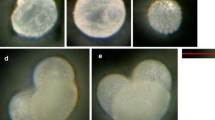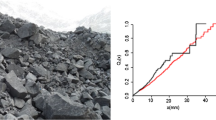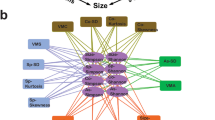Abstract
A simple method for measuring the settling velocity (V s) distribution of pollen and spores 30–100 μm in diameter is detailed and evaluated. The method is called the ‘settling tower' and consists in taking sequential pictures of particles falling under gravity in calm air. The scene is illuminated by a cold light source, while a camera takes 15 pictures per second. Between 20,000 and 100,000 images are analysed to obtain the distribution of V s for a given set of particles. The method was validated using two standard particles with mean diameters of 68 and 108 μm, respectively, as well as Lycopodium spores, with a mean diameter of 35 μm. For each set of particles, the theoretical V s distribution was estimated from the particle diameter distribution and the volumetric mass using a non-Stokian law, as the Reynolds numbers of the particles were large. The mean V s was measured with the ‘settling tower' with less than 12% error, while the standard deviation of the V s distribution was estimated with less than 51% error. The maximum error on the mean V s was 12% for the Lycopodium spores and less than 2% for the two larger particles. The mean V s of Lycopodium spores was 4.2 cm s−1, and its standard deviation was 0.7 cm s−1. The reason for the small overestimation of V s for Lycopodium spores by the ‘settling tower' method is discussed. Preliminary measurements shows that, the ‘settling tower' could be of great practical interest for measuring the distribution of V s of maize pollen as well as other types of pollen or spores.






Similar content being viewed by others
References
Adrian, R. J. (1991). Particle-imaging techniques for experimental fluid mechanics. Annual Review of Fluid Mechanics, 23, 261–304.
Aylor, D. E. (2002). Settling speed of corn (Zea mays) pollen. Journal of Aerosol Science, 33, 1601–1607.
Aylor, D. E. (2003). Rate of dehydration of corn (Zea mays L.) pollen in the air. Journal of Experimental Botany, 54, 2307–2312.
Aylor, D. E., & Taylor, G. S. (1983). Escape of Peronospora Tabacina spores from a field of diseased Tobacco plants. Phytopathology, 73, 525–529.
Aylor, D. E., & Irwin, M. E. (1999). Aerial dispersal of pests and pathogens: implications for integrated pest management. Agricultural and Forest Meteorology, 97, 233–234.
Aylor, D. E., Schultes, N. P., & Shields, E. J. (2003). An aerobiological framework for assessing cross-pollination in maize. Agricultural and Forest Meteorology, 119, 111–129.
DiFelice, R. (1996). A relationship for the wall effect on the settling velocity of a sphere at any flow regime. International Journal of Multiphase Flow, 22, 527–533.
Di-Giovanni, F., Kevan, P. G., & Nasr, M. E. (1995). The variability in settling velocities of some pollen and spores. Grana, 34, 39–44.
Dupont, S., Brunet, Y., & Jarosz, N. (2006). Eulerian modelling of pollen dispersal over heterogenous vegetation canopies. Agricultural and Forest Meteorology, 141, 82–104.
Ferrandino, F. J., & Aylor, D. E. (1984). Settling speed of clusters of spores. Phytopatholgy, 74, 969–972.
Fields, T. B. (2002). Aerodynamic time-of-flight particle size measurement. Journal of Dispersion Science and Technology, 23, 729–735.
Fuchs, N. A. (1964). The mechanics of aerosols. New York: Macmillan.
Gregory, P. H. (1973). Microbiology of the atmosphere. New York: John Wiley & Sons.
Haskell, G., & Dow, P. (1951). Studies with sweet corn V. Seed-settings with distances from pollen source. Empire Journal of Experimental Agriculture, 19, 45–50.
Jarosz, N., Loubet, B., Durand, B., McCartney, H. A., Foueillassar, X., & Huber, L. (2003). Field measurements of airborne concentration and deposition of maize pollen. Agricultural and Forest Meteorology, 119, 37–51.
Jarosz, N., Loubet, B., & Huber, L. (2004). Modelling airborne concentration and deposition rate of maize pollen. Atmospheric Environment, 38, 5555–5566.
Jarosz, N., Loubet, B., Durand, B., Foueillassar, X., & Huber, L. (2005). Variations in maize pollen emission and deposition in relation to microclimate. Environmental Science and Technology, 39, 4377–4384.
Klein, E. K., Lavigne, C., Foueillassar, X., Gouyon, P. H., & Laredo, C. (2003). Corn pollen dispersal: Quasi-mechanistic models and field experiments. Ecological Monographs, 73, 131–150.
Lavigne, C., Godelle, B., Reboud, X., & Gouyon, P. H. (1996). A method to determine the mean pollen dispersal of individual plants growing within a large pollen source. Theoretical and Applied Genetics, 93, 1319–1326.
Lavigne, C., Klein, E. K., Vallee, P., Pierre, J., Godelle, B., & Renard, M. (1998). A pollen-dispersal experiment with transgenic oilseed rape. Estimation of the average pollen dispersal of an individual plant within a field. Theoretical and Applied Genetics, 96, 886–896.
Lavigne, C., Klein, E. K., & Couvet, D. (2002). Using seed purity data to estimate an average pollen mediated gene flow from crops to wild relatives. Theoretical and Applied Genetics, 104, 139–145.
Luna, V. S., Figueroa M. J., Baltazar M. B., Gomez L. R., Townsend R., & Schoper, J. B. (2001). Maize pollen longevity and distance isolation requirements for effective pollen control. Crop Science, 41, 1551–1557.
Malcolm, L. P., & Raupach, M. R. (1991). Measurements in an air settling tube of the terminal velocity distribution of soil material. Journal of Geophysical Research, 96, 15275–15286.
McCartney, H. A. (1994). Dispersal of spores and pollen from crops. Grana, 33, 76–80.
Rambert, A., Huber, L., & Gougat., P. (1998). Laboratory study of fungal spore movement using Laser Doppler Velocimetry. Agricultural and Forest Meteorology, 92, 43–53.
Renoux, A., & Boulaud, D. (1998). Les aérosols. Physique et Métrologie. Paris: Lavoisier.
Sawyer, A. J., Griggs, M. H., & Wayne, R. (1994). Dimensions, density, and settling velocity of entomophthoralean Conidia : implications for aerial dissemination of spores. Journal of Invertebrate Pathology, 63, 43–55.
Seinfeld, J. H., & Pandis, S. N. (1998). Atmospheric chemistry and physics. From air pollution to climate change. New York: Wiley-Interscience.
Author information
Authors and Affiliations
Corresponding author
Rights and permissions
About this article
Cite this article
Loubet, B., Jarosz, N., Saint-Jean, S. et al. A method for measuring the settling velocity distribution of large biotic particles. Aerobiologia 23, 159–169 (2007). https://doi.org/10.1007/s10453-007-9054-2
Received:
Revised:
Accepted:
Published:
Issue Date:
DOI: https://doi.org/10.1007/s10453-007-9054-2




